

Singular Sensations. Me, Myself and Math, a six-part series by Steven Strogatz, looks at us through the lens of math.
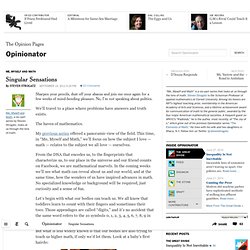
Sharpen your pencils, dust off your abacus and join me once again for a few weeks of mind-bending pleasure. No, I’m not speaking about politics. We’ll travel to a place where problems have answers and truth exists. The haven of mathematics. Friends You Can Count On. Me, Myself and Math , a six-part series by Steven Strogatz, looks at us through the lens of math.
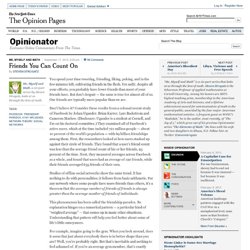
You spend your time tweeting, friending, liking, poking, and in the few minutes left, cultivating friends in the flesh. Yet sadly, despite all your efforts, you probably have fewer friends than most of your friends have. But don’t despair — the same is true for almost all of us. Our friends are typically more popular than we are. Don’t believe it? Studies of offline social networks show the same trend. This phenomenon has been called the friendship paradox. For example, imagine going to the gym. This is also why people experience airplanes, restaurants, parks and beaches to be more crowded than the averages would suggest. Weighted averages are the natural measures to use in such cases. The university would say 50, because (90 + 10)/2 = 50. Proportion Control. It's My Birthday Too, Yeah. Dangerous Intersection. Me, Myself and Math, a six-part series by Steven Strogatz, looks at us through the lens of math.
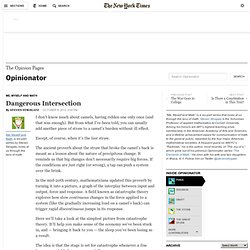
I don’t know much about camels, having ridden one only once (and that was enough). But from what I’ve been told, you can usually add another piece of straw to a camel’s burden without ill effect. Except, of course, when it’s the last straw. The ancient proverb about the straw that broke the camel’s back is meant as a lesson about the nature of precipitous change. It reminds us that big changes don’t necessarily require big forces. Me, Myself and Math - Opinionator. By an amazing coincidence my sister, Cathy, and my Aunt Vere have the same birthday: April 4.
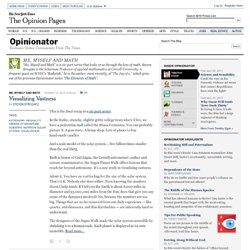
Actually, it’s not so amazing. In any extended family with enough siblings, aunts, uncles and cousins, you’d expect at least one such birthday coincidence. Certainly, if there are 366 people in the family — more relatives than days of the year — they can’t have different birthdays, so a match is guaranteed in a family this big. (Or if you’re worried about leap year, make it 367.) But suppose we don’t insist on absolute certainty. The answer, just 23 people, comes as a shock to most of us the first time we hear it. John Allen Paulos gave a vivid example of this error in his trenchant best seller “Innumeracy”: A couple of years ago, someone on the Johnny Carson show was trying to explain [why 23 is the answer to the birthday problem].
Visualizing Vastness. Me, Myself and Math, a six-part series by Steven Strogatz, looks at us through the lens of math.
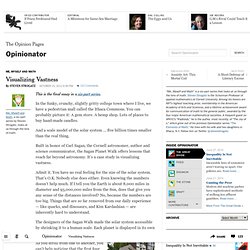
This is the final essay in a six-part series. In the funky, crunchy, slightly gritty college town where I live, we have a pedestrian mall called the Ithaca Commons. You can probably picture it: A gem store. A hemp shop. Lots of places to buy hand-made candles. And a scale model of the solar system … five billion times smaller than the real thing. Built in honor of Carl Sagan, the Cornell astronomer, author and science communicator, the Sagan Planet Walk offers lessons that reach far beyond astronomy. Admit it. The designers of the Sagan Walk made the solar system accessible by shrinking it to a human scale.
Leah Strogatz As you stroll from one to another, you can’t help noticing that the first four planets are really close together. The planets themselves are scaled down too, in exact proportion. Equity-based Educational Reform in Finland. In the Helsinki stage of our on-going Equity/Transport program and process, it is particularly important that we have and share a clear understanding of the manner in which the equity-base reform process has transformed Finland’s schools over the last decades from middling to world level (See OECD PISA results for verification).
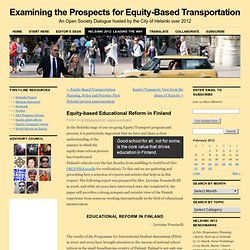
To this end we are gathering and presenting here a selection of reports and articles that help us in this respect. The following report was prepared by Mrs. Education in Finland. Education in Finland is a system with no tuition fees and with fully subsidised meals served to full-time students.
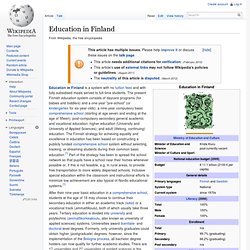
The present Finnish education system consists of daycare programs (for babies and toddlers) and a one-year "pre-school" (or kindergarten for six-year-olds); a nine-year compulsory basic comprehensive school (starting at age seven and ending at the age of fifteen); post-compulsory secondary general academic and vocational education; higher education (University and University of Applied Sciences); and adult (lifelong, continuing) education. After their nine-year basic education in a comprehensive school, students at the age of 16 may choose to continue their secondary education in either an academic track (lukio) or a vocational track (ammattikoulu), both of which usually take three years. Tertiary education is divided into university and polytechnic (ammattikorkeakoulu, also known as university of applied sciences) systems.
Basic comprehensive education[edit]
OLI. The Simon Initiative. Built on the core principles of learning advanced by CMU’s Nobel Laureate and pioneering educator, Dr.
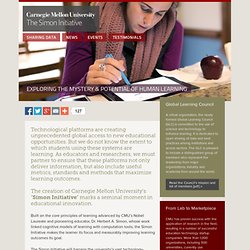
Herbert A. Simon, whose work linked cognitive models of learning with computation tools, the Simon Initiative makes the learner its focus and measurably improving learning outcomes its goal. The Simon Initiative will harness the university’s vast technology-enhanced, educational ecosystem that has emerged over the last several decades: faculty, departments, and centers focused on improving pedagogy, advancing research and leveraging technology; a large existing learner-interaction database for understanding learner experiences; seed-funding of new ideas and activities; spinout companies; and the scientific vision and interdisciplinary creativity for which CMU is renowned.
The Simon Initiative will also bring together leading universities, foundations and companies in a new Global Learning Council [pdf] led by CMU to partner in this important effort and develop best practices. La Educación Prohibida. Hispanic Momentum in Computing. April 2013 Vol. 25/No.4 By Ann Q.

Gates, Sarah Hug, and Heather Thiry Hispanics have the highest growth rates among all groups in the United States, yet they remain considerably underrepresented in computing careers and in the numbers who obtain advanced degrees. Hispanicscomprise only 13 percent of undergraduate students in all fields. Additionally, only seven percent of baccalaureates and less than one percent of doctorates in computer science in 2011 were granted to Hispanic U.S. citizens (National Center for Education Statistics (NCES), 2011)
. · California State University-Dominguez Hills (CSU-DH) – Mohsen Beheshti · Florida International University (FIU) – Malek Adjouadi · New Mexico State University (NMSU) – Enrico Pontelli.